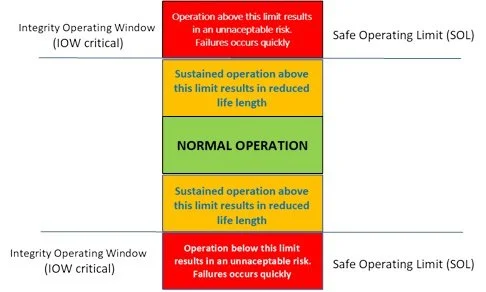The Difference Between Safe Operating Limits (SOL) and Integrity Operating Windows (IOW)
by Lenin Elorza, 6/18/2018 5 CommentsTags: Integrity Operating Windows Mechanical Integrity Safe Operating Limits
An AOC consultant, a process engineer, and a reliability engineer discuss the differences between Safe Operating Limits, Standard Limits, and Integrity Operating Windows.

Is there any difference between Safe Operating Limits (SOL) and Integrity Operating Windows (IOW)?
Short answer is NO.
But let me tell you how all this started.
I was recently in a meeting where 2 engineers were talking about this topic. One of them was a process engineer, the other one was reliability engineer.
The process engineer was talking about the importance of defining a Technical Operating Envelope in their facility where they can easily identify the Safe Operating Limits (SOL) and standard limits. He indicated that the Technical Operating Envelope consists of the operating limits of a unit that specifies safe mechanical and process performance limits between minimum and maximum operating parameters.
He continued speaking and stated that a SOL is operating parameter, such as pressure, temperature or flow, that defines the limit to which equipment within the plant process can be safely operated. Deviating from the safe operating limit can result in immediate and severe consequences to health, safety and the environment.
On the other side of the table, the reliability engineer stated that from his point of view the most important items to be defined were the Integrity Operating Windows, both critical and standard. He clearly said that IOWs are derived from performing a corrosion hazard analysis. He also mentioned that IOWs are defined values for process variables that can affect the mechanical integrity of an asset if the operation deviates from the established limits for a predetermined length of time.
Both went back and forth on the validity and importance of the SOL and IOW critical. They both agreed on one fundamental topic: Process Engineering and Reliability Engineering personnel must report, investigate and take action on any SOL and IOW critical excursions.
At some point in the conversation, both looked at me and asked "What is your opinion on this matter?"
I said, "You both are correct on your statements."
They thought I was just joking and asked, "What do you mean?"
I replied that SOL and IOW critical are basically the same thing.
If you put an SOL chart and IOW critical chart together, they will look like this:

What most people consider "differences" between SOL and IOW critical is just the approach either Operations / Process Engineering / Reliability Engineering or Maintenance groups within an organization decide to manage.
In general, for Operations and Process Engineering, Safe Operating Limits (SOL) related to safety and asset performance. For Reliability Engineering and Maintenance, Integrity Operating Windows (IOW critical) are related to safety and asset life reduction.
Both looked at me and said, this is an Ah-Ha moment... They agreed that SOL and IOW critical are equivalents; what they initially viewed as differences were just a result of their different perspectives. The process engineer was looking at the overall function of the plant or unit and the reliability engineer was focused on the mechanical integrity of the asset or equipment. Same thing, just different perspectives!!
For more guidance or assistance with your own IOWs, Integrity Operating Window Development is one of the services that we offer here at AOC. Shoot us a note and we can help get you started with your next project.
Add your comment
Related Services
Key parameters and mitigating actions for variables that may dramatically affect the intended design life of your asset
A maintenance system designed in which elements work together as a quality system for maximum returns
AOC delivers the policies, procedures, work processes, knowledge and actions such as preventive maintenance, predictive maintenance, and condition monitoring tasks.
Related Tools
Create mechanical integrity (MI) program value rather than it being seen as a necessary cost to minimize.
Is your plant's MI program compliant? Use our checklist to assess your current program against industry standards and receive expert recommendations for improvement.
Related Training
A high level overview introducing Mechanical Integrity and Risk Based Inspection
How do I use GE APM to perform MI/RBI tasks?
What are your goals for RBI? How will you measure your success? How will you sustain that success?
How important are they?
Related Knowledge
Can Non-Intrusive Inspection (NII) finally replace vessel entries? Explore the roadblocks to RBI, validated POD data for UT and RT, and a new framework for technical equivalency in modern refinery maintenance.
Why companies overlook Mechanical Integrity: It's expensive, exposes risk, requires specialized knowledge, and is difficult to audit. Learn the 10 structural, cultural, and economic reasons MI is the weakest PSM element.
Discover why equipment failure is the root cause of most catastrophic incidents. Mechanical Integrity (MI) is the non-negotiable foundation that prevents loss of containment and protects your entire PSM system. Learn the 8 reasons MI is essential.
Refinery incidents, especially fires & explosions, appear to be increasing since 2018, though industry-reported safety metrics show a drop. We look at the data, the debate, and why the numbers conflict.
PHMSA vs. OSHA: Understanding the Overlap Hydrocarbon facilities like pipelines, refineries, and terminals often fall under both PHMSA (DOT) and OSHA (DOL). Learn where each agency's jurisdiction begins and ends, and how to coordinate your integrity programs for compliance.
Rate reduction on new projects to support the industry during the current extended downturn.
What are equipment/inspection strategies in relation to mechanical integrity (MI) and risk based inspection (RBI)?
This is a practical approach to incorporating the new PHMSA gas well rules into your integrity program with the rest of your surface and subsurface assets.
A dysfunctionality found in many refineries, chemical plants, and other production facilities, is a lack of common asset management work processes.
A look at how the financial sector's concept of Asset Value Management can be applied to the petrochemical industry.


Comments